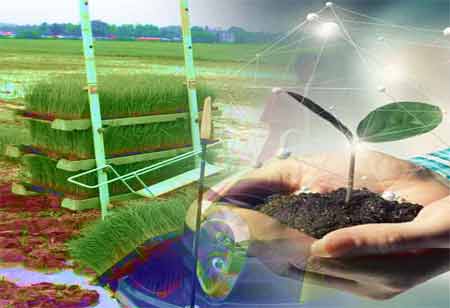By
Agri Business Review | Monday, December 11, 2023
Stay ahead of the industry with exclusive feature stories on the top companies, expert insights and the latest news delivered straight to your inbox. Subscribe today.
Agroforestry offers a promising solution to sustainability, regenerative agriculture, and climate change in the tropics, ensuring food security, biodiversity conservation, and climate mitigation.
FREMONT, CA: The significance of agroforestry as a sustainable land-use management approach to address challenges associated with sustainable agriculture in tropical regions is increasingly gaining recognition. This integrated methodology offers a myriad of environmental, economic, and social advantages by amalgamating the cultivation of woody perennials or trees with conventional crops or livestock.
In light of its multifaceted benefits and its potential contribution to a more environmentally sustainable future, the Sustainable Agriculture Network actively endorses agroforestry as a viable and regenerative agricultural solution for tropical regions.
The Importance of Agroforestry in Tropical Regions
Biodiversity Conservation: These systems serve as conducive environments for a diverse array of organisms, offering both sustenance and shelter. By emulating natural ecosystems, these systems consistently contribute to the augmentation of biodiversity within the designated areas. Particularly in tropical climates characterised by unusually elevated biodiversity, agroforestry assumes a pivotal role in safeguarding essential flora and fauna.
Soil Health and Fertility: Agroforestry systems incorporating trees contribute significantly to enhancing soil fertility through effective erosion control, nutrient cycling, and the accumulation of organic matter. Furthermore, the presence of tree roots plays a crucial role in mitigating soil compaction, thereby facilitating improved aeration and water infiltration.
Climate Change Mitigation: Trees play a pivotal role in mitigating climate change as significant quantities of carbon dioxide are absorbed and sequestered within their structure, rendering them highly effective carbon sinks. The practice of agroforestry emerges as a strategic approach to attenuate global warming by reducing overall greenhouse gas emissions. Additionally, this technique contributes to the amelioration of local microclimates, offering valuable benefits such as shading and tempering temperature extremes.
Enhanced Crop Yields: The provision of tree shade serves as a vital mechanism in safeguarding crops against temperature-related stressors, thereby enhancing both the quality and yield of agricultural produce. Furthermore, the natural fertilisation effect resulting from the leaf litter generated by trees contributes to a reduction in the dependency on artificial inputs for crop cultivation.
Economic Diversification: Agroforestry serves as a strategic means to diversify farmers' revenue streams, incorporating timber, fruits, nuts, and non-timber forest products alongside traditional agricultural and livestock commodities. This comprehensive approach enhances economic resilience and also contributes to stability in the agricultural sector.
Resilience to Extreme Weather: Agroforestry systems provide valuable safeguards against adverse weather conditions, including storms and strong winds. Moreover, they contribute significantly to mitigating the potential risks of landslides and soil erosion in tropical regions, particularly during periods of excessive rainfall.
Examples of Agroforestry Practices in Tropical Regions
Forest Farming: Forest farming refers to the practice of cultivating crops within the understory or beneath the canopy of a forest. This approach maximises the utilisation of the forest's existing structure while leveraging the shade tolerance of select crops to create optimal growth conditions. The application of forest farming proves highly advantageous in regions facing limited availability of arable land.
Taungya System: This agricultural methodology involves intercropping crops within the interstices of rapidly growing trees. This approach serves as an effective strategy for rehabilitating depleted lands while concurrently ensuring a consistent provision of timber resources.
Silvopastoral Systems: This integrated approach, intertwining livestock husbandry with arboreal cultivation, enhances feed quality and mitigates strain on pastureland. Trees provide supplementary nourishment, shade, and potential wood resources for the animals.
Home Gardens: In the gardens of numerous tropical households, an extensive array of fruits, vegetables, and utilitarian plants are cultivated. This practice serves as a vital source of essential nutrients and also fosters a sense of self-reliance and sustainability within these communities.
Alley Cropping: This method involves strategically planting crops alongside rows of trees. Beyond providing essential benefits such as shade, windbreaks, erosion control, and habitats for beneficial insects, trees offer additional advantages. Moreover, the organic matter contributed by tree litter significantly enhances soil fertility, augmenting overall agricultural productivity.
In tropical regions, agroforestry presents a compelling solution to pressing issues of sustainability, regenerative agriculture, and adaptation to climate change. The integration of trees into agricultural environments effectively mitigates the impacts of climate change, fosters biodiversity conservation, enhances soil health, and reinforces food security measures. Recognising the pivotal role of agroforestry, collective efforts are imperative to advance its extensive implementation. By fostering widespread adoption, individuals and organisations can significantly contribute to cultivating greener, more sustainable futures for tropical regions and the global ecosystem at large. 





